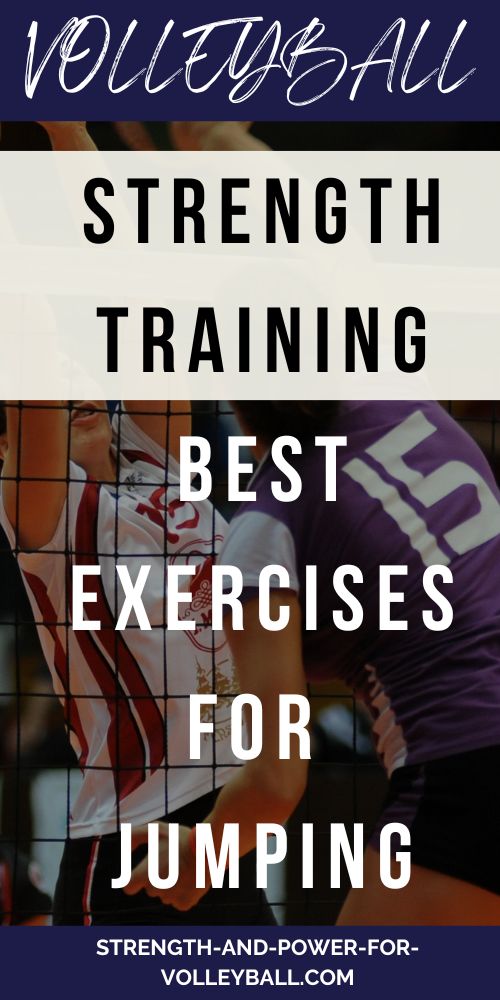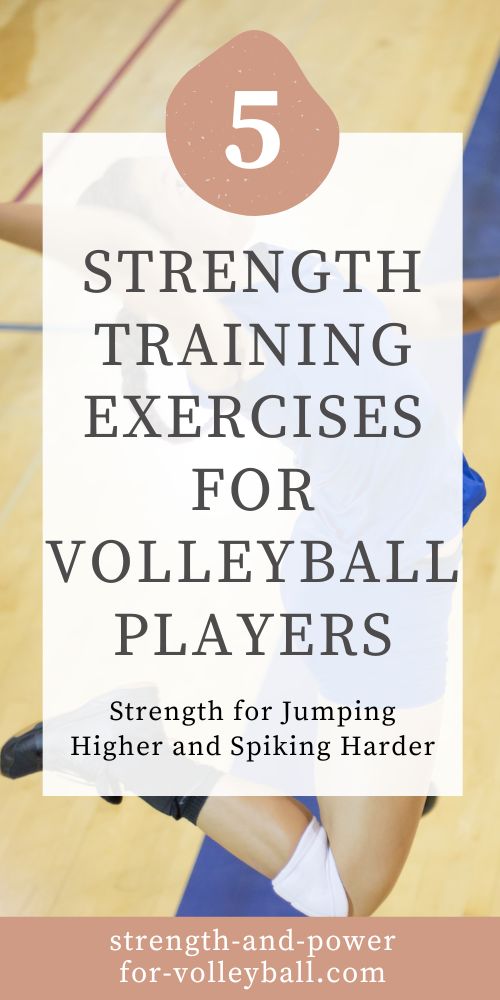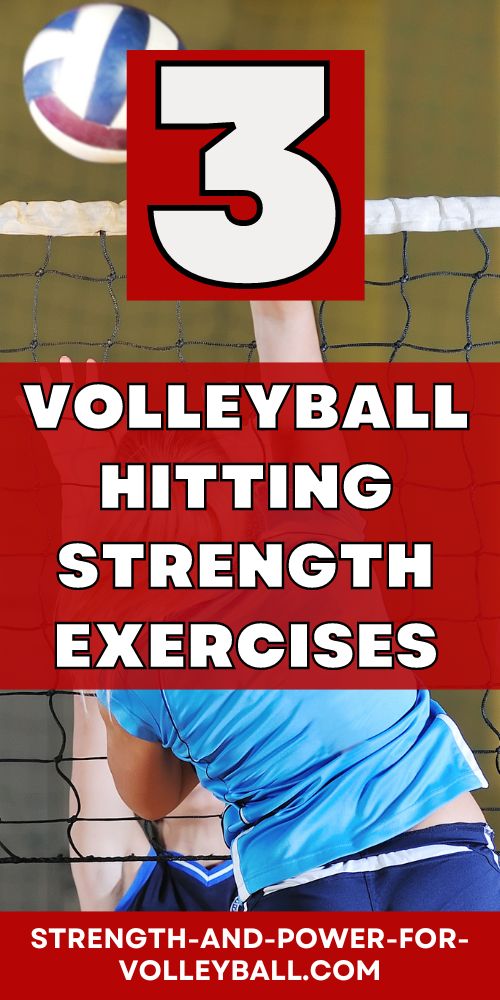Strength Training for Volleyball
Exercises and Workout Tips
Strength training for volleyball involves movements like push-ups, body weight lunges, and core exercises. This is type of training is all you need for a great start getting stronger for volleyball.
Volleyball Specific Strength Training
The best strength training for volleyball will depend on the individual athlete and team goals.
However, here are some general principles of strength training for volleyball.
Compound Movements. A compound movement, such as squats, deadlifts, and pull-ups, are highly effective at building overall strength and muscle mass. To jump high in volleyball, you need to train the muscle groups that are involved in jumping. Before you jump, your ankles, knees, and hips flex. As you jump, your body performs a movement called a "triple extension". This refers to the extension of the 3 major joints of the lower body (ankles, knees, and hips). Compound exercises such as squat jumps activate muscles involved in the triple extension.
Adding hip flexion and extension exercises to your training will help you become stronger at jumping to hit and block in volleyball.
Movements that work multiple muscle groups at once are more functional, meaning, training body as it would naturally perform in volleyball or daily life. The best exercises a volleyball player involve pushing, pulling and rotating which will help to improve coordination and balance.
Specificity. Your volleyball strength training needs to be specific to the demands of volleyball. For example, a volleyball player that needs to hit a volleyball with a lot of power may benefit from exercises that focus on shoulder and upper back strength.
Plyometrics. Plyometric movements such as jumping to box and squat jumps, can help improve a volleyball player's explosiveness and power for jumping higher in volleyball. The medicine ball rotational throw is an exercise that improves the transfer of power from the lower to upper body. This exercise develops power in the core and hip muscles that lead to stronger and more explosive spikes and serves.
Periodization: Periodization is a training method of dividing a workout program into specific phases or cycles. Periodization for volleyball players will help athletes avoid overtraining and gradually become stronger and more athletic volleyball players. An example of periodization would be creating a separate workout programs for in-season vs off-season.
Progressive overload: Progressive overload involves gradually increasing the intensity and difficulty of a workout over a period of time. You want to progressively challenge the muscles to promote muscular growth. When done properly, you allow the body to adapt to the workouts which helps avoid overtraining and injury.
5 Strength Training Exercises for Volleyball
Here are 5 compound movements that are great for improving strength for volleyball.
Dumbbell Squats.
- Stand with your feet shoulder-width apart and hold a dumbbell in each hand, with your arms straight and the dumbbells at your sides.
- Engage your core and keep your chest up as you begin to bend your knees and lower your hips back and down, as if you were sitting back into a chair.
- Keep your weight in your heels and your knees tracking in line with your toes as you lower yourself down until your thighs are parallel to the ground.
- Pause for a moment at the bottom of the squat, then push through your heels to stand back up to the starting position, squeezing your glutes at the top of the movement.
Make sure to keep your knees tracking in line with your toes and avoid letting them collapse inward. Keep your chest up and engage your core throughout the movement to maintain good posture. Use a weight that challenges you but allows you to maintain proper form.
Dumbbell Deadlifts.
- Stand with your feet shoulder-width apart, with a dumbbell in each hand held at your sides.
- Hinge at your hips and bend your knees slightly, while keeping your back straight and your core engaged. This is your starting position.
- Lower the dumbbells down towards the ground while keeping them close to your body. You should feel a stretch in your hamstrings and glutes.
- Once the dumbbells reach mid-shin level or your maximum range of motion, pause for a moment, then lift the dumbbells back up to the starting position by driving through your heels and engaging your glutes and hamstrings.
- As you lift the dumbbells, focus on keeping your back straight and your core engaged to avoid rounding your spine.
Start with a lighter weight until you have mastered the movement to avoid injury. Keep your spine in a neutral position throughout the movement to avoid rounding your back.
Avoid using your arms to lift the dumbbells. Instead, focus on engaging your glutes, hamstrings, and core to perform the lift. Keep the dumbbells close to your body throughout the movement.
Dumbbell Lunges.
- Stand with your feet hip-width apart, holding a dumbbell in each hand with your arms at your sides.
- Take a step forward with one foot, keeping your torso upright and your core engaged.
- Lower your back knee down towards the ground by bending both knees, keeping your front knee directly above your ankle.
- Pause for a moment at the bottom of the lunge, then push through your front heel to raise your body back up to the starting position.
- Repeat on the other side by stepping forward with your other foot.
Keep your torso upright throughout the movement to avoid leaning forward or rounding your back. Keep your front knee directly above your ankle to avoid placing excess stress on your knee joint.
Use a weight that challenges you but allows you to maintain proper form. Start with a shorter stride length and gradually increase as you become more comfortable with the movement. Engage your core throughout the movement to maintain good posture.
Squat Jumps.
- Stand with your feet shoulder-width apart, with your toes pointing slightly outward.
- Lower your body down into a squat position by bending at your knees and hips, while keeping your chest up and your back straight.
- From the squat position, explosively jump upward by extending your hips and knees, while swinging your arms upward for momentum.
- Reach the highest point of your jump by fully extending your body, then land back in the starting position by bending your knees and hips to absorb the impact.
Keep your chest up and your back straight throughout the movement to maintain good posture. Use your arms to generate momentum and power for your jump.
Land softly by bending your knees and hips to absorb the impact, rather than landing with locked joints. Start with a lower jump height and gradually increase as you become more comfortable with the movement.
Strength Training for Volleyball & Stronger Spiking
Here are 3 strength training for volleyball exercises for becoming a stronger hitter.
Shoulder external rotation with a resistance band.
- Begin by attaching a resistance band to a stationary object at shoulder height.
- Stand facing the anchor point with your feet shoulder-width apart and your elbow bent at a 90-degree angle, holding the resistance band with your palm facing inwards.
- Keep your upper arm close to your body and slowly rotate your forearm outward, away from your body, while keeping your elbow in the same position.
- Hold for a moment at the end of the movement, then slowly return to the starting position, with your forearm parallel to the ground.
- Repeat for the desired number of reps, then switch to the other arm.
Use a light resistance band to start, and gradually increase resistance as you become more comfortable with the movement. Keep your elbow close to your body throughout the movement to isolate the rotator cuff muscles.
Control the movement on both the inward and outward rotation to maintain proper form.
Keep your core engaged and avoid arching your back during the movement.
Scapular retraction exercise.
- Begin by standing or sitting with your back straight and your arms at your sides.
- Squeeze your shoulder blades together and pull them back, while keeping your shoulders down and relaxed.
- Hold for a moment at the end of the movement, then release.
Focus on squeezing your shoulder blades together and pulling them back, rather than shrugging your shoulders up towards your ears. Keep your shoulders down and relaxed throughout the movement to avoid unnecessary tension.
Engage your core muscles to maintain proper posture throughout the movement. Start with a small range of motion and gradually increase as you become more comfortable with the movement. You can also perform this exercise with a resistance band by anchoring the band to a stationary object and pulling it towards your body with your arms at your sides.
Dumbbell shoulder press.
- Begin by standing or sitting with your back straight and your feet shoulder-width apart.
- Hold a dumbbell in each hand at shoulder height, with your palms facing forward and your elbows bent.
- Engage your core muscles and press the dumbbells upward towards the ceiling, fully extending your arms.
- Hold for a moment at the top of the movement, then slowly lower the dumbbells back down to shoulder height.
Start with a light weight and gradually increase as you become more comfortable with the movement. Keep your elbows close to your body throughout the movement to avoid unnecessary strain on your shoulders.
Keep your back straight and your core engaged to maintain proper posture. Exhale as you press the dumbbells upward, and inhale as you lower them back down. You can also perform this exercise seated, using a bench with back support.
If you enjoyed these strength training for volleyball tips and would like to keep them close to you, just save this pin to your Pinterest Volleyball Training Board.
- Home
- workout for volleyball
- Strength Training for Volleyball


